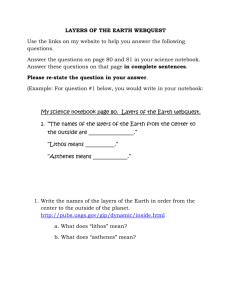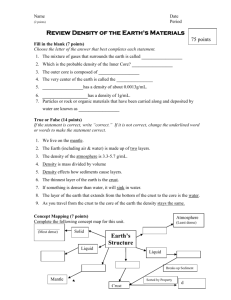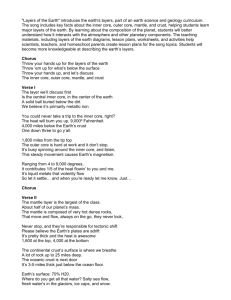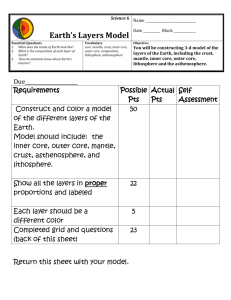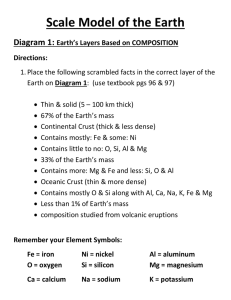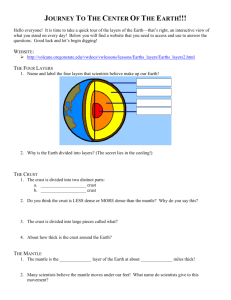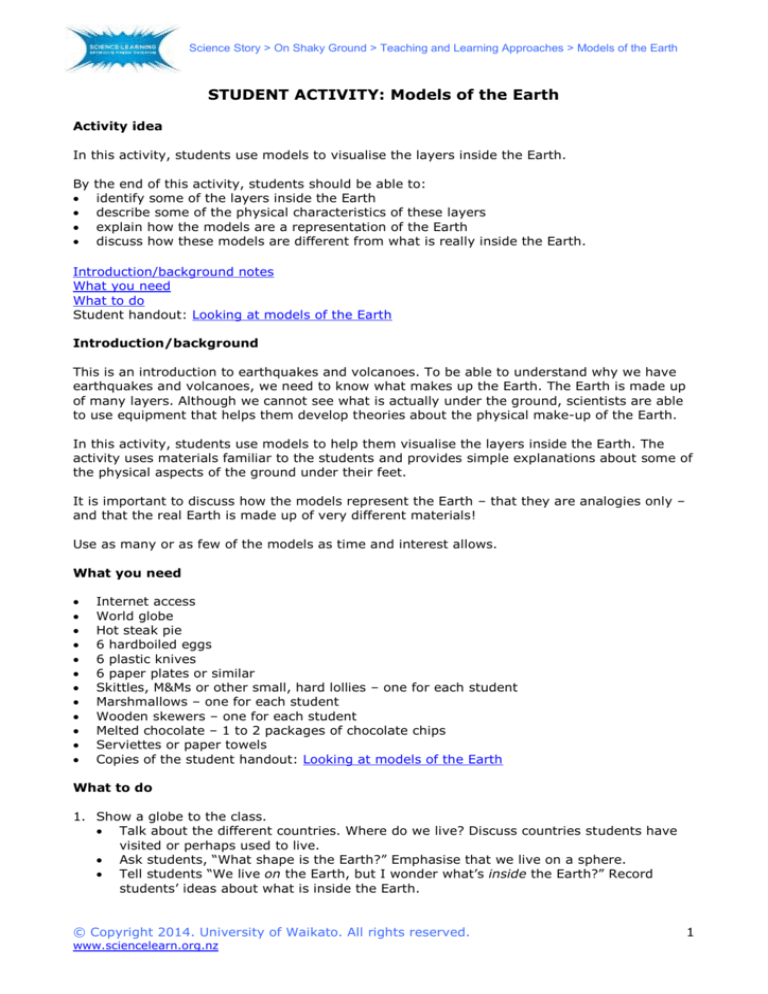
Science Story > On Shaky Ground > Teaching and Learning Approaches > Models of the Earth
STUDENT ACTIVITY: Models of the Earth
Activity idea
In this activity, students use models to visualise the layers inside the Earth.
By
the end of this activity, students should be able to:
identify some of the layers inside the Earth
describe some of the physical characteristics of these layers
explain how the models are a representation of the Earth
discuss how these models are different from what is really inside the Earth.
Introduction/background notes
What you need
What to do
Student handout: Looking at models of the Earth
Introduction/background
This is an introduction to earthquakes and volcanoes. To be able to understand why we have
earthquakes and volcanoes, we need to know what makes up the Earth. The Earth is made up
of many layers. Although we cannot see what is actually under the ground, scientists are able
to use equipment that helps them develop theories about the physical make-up of the Earth.
In this activity, students use models to help them visualise the layers inside the Earth. The
activity uses materials familiar to the students and provides simple explanations about some of
the physical aspects of the ground under their feet.
It is important to discuss how the models represent the Earth – that they are analogies only –
and that the real Earth is made up of very different materials!
Use as many or as few of the models as time and interest allows.
What you need
Internet access
World globe
Hot steak pie
6 hardboiled eggs
6 plastic knives
6 paper plates or similar
Skittles, M&Ms or other small, hard lollies – one for each student
Marshmallows – one for each student
Wooden skewers – one for each student
Melted chocolate – 1 to 2 packages of chocolate chips
Serviettes or paper towels
Copies of the student handout: Looking at models of the Earth
What to do
1. Show a globe to the class.
Talk about the different countries. Where do we live? Discuss countries students have
visited or perhaps used to live.
Ask students, “What shape is the Earth?” Emphasise that we live on a sphere.
Tell students “We live on the Earth, but I wonder what’s inside the Earth?” Record
students’ ideas about what is inside the Earth.
© Copyright 2014. University of Waikato. All rights reserved.
www.sciencelearn.org.nz
1
Science Story > On Shaky Ground > Teaching and Learning Approaches > Models of the Earth
2. Bring out a hot steak pie. Hold it in front of the class and tell them that the pie is more
than your lunch – it is a model of the Earth! Cut into the top layer of crust and watch as
gravy (and possibly steam) comes to the surface. Discuss what’s inside the pie, what’s on
the outside, and then put the pie in a safe place for later use.
3. If appropriate, read through the articles Under the Earth’s surface and The moving Earth
with the class. Discuss the content vocabulary, ‘core’, ‘mantle’, ‘crust’ and ‘tectonic plates’.
4. Look at the image Inside the Earth. Discuss the layers with the students.
5. Explain that scientists often use models to demonstrate concepts or things we cannot see
because they are too small, too far away or – like the Earth’s layers – too deep down for us
to dig. This activity will involve making models of the Earth’s layers.
6. Hand out the hardboiled eggs to groups of students. Instruct them to cut the eggs in half
with the plastic knives and then to examine each half of the egg.
7. Ask students how the egg could represent the Earth:
The yolk represents the core – if it is overcooked, there will be a grey coating on the
yolk that can represent the outer core, the yellow yolk the inner core.
The white represents the mantle. It is ‘squishy’ – the mantle behaves a bit like a liquid
and a solid.
The shell represents the Earth’s crust. It is thin, and when cracked, the cracks
represent the edges of tectonic plates.
8. Discuss how the eggs work as a model. Discuss the similarities and differences between the
egg and the actual layers of the Earth. (The Earth is made of geological materials like iron,
rock and magma.)
9. Make edible models of the Earth with the students. Place a small,
hard Skittle or M&M lolly (the core) in the centre of the
marshmallow (the ‘squishy’ mantle). Insert a skewer to hold the
marshmallow. Take turns dipping the marshmallows into the
melted chocolate. Students then hold the skewer until the
chocolate hardens and becomes the thin crust. Once hard,
students can gently pinch the chocolate so small cracks form to
represent tectonic plates.
10. Discuss how the edible Earth works as a model. Discuss the similarities and differences
between the edible Earth and the actual layers of the Earth.
11. Take out the steak pie. Ask students to identify how it works as a model.
Pastry represents the crust.
Hot gravy and steam oozing from a crack in the pastry/crust represents magma/lava
from the mantle.
Pieces of steak represent the solid inner core.
Then ask how it differs to the real Earth.
12. Pass out copies of the student handout: Looking at models of the Earth. Ask students to
draw and label the models. Older students can add similarities and differences between the
models and the actual Earth. (Note, the worksheet is in Word, so teachers are encouraged
to modify it to suit their needs.)
13. Once the worksheet is completed, students can eat their models.
© Copyright 2014. University of Waikato. All rights reserved.
www.sciencelearn.org.nz
2
Science Story > On Shaky Ground > Teaching and Learning Approaches > Models of the Earth
Student handout: Looking at models of the Earth
Draw a picture of each model. Label the core, mantle, crust and tectonic plates.
Write a sentence about how this model is the same or different to the real Earth.
The real Earth
A hardboiled egg
A meat pie
Lolly/marshmallow/chocolate creation
© Copyright 2014. University of Waikato. All rights reserved.
www.sciencelearn.org.nz
3


